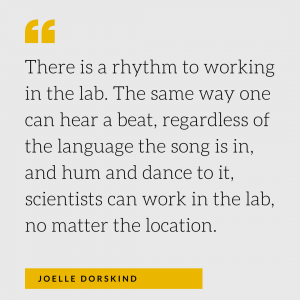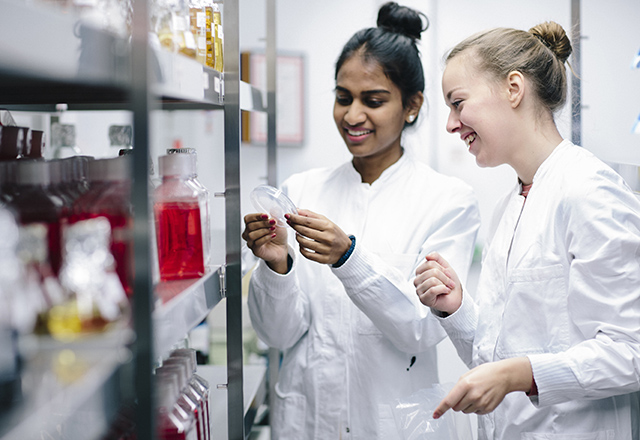On the floor where I work in the preclinical teaching building at the Johns Hopkins University School of Medicine, there are a variety of postdoctoral fellows, students, technicians and faculty from all over the world. We have postdoctoral fellows from China, Portugal and Israel, and graduate students from Germany, Canada and Taiwan. You can always find someone on the phone chatting in their native language; the diversity of cultures and backgrounds is immense and so special. We all share language, culture and food from our homes during lunch and coffee breaks. Though the hallways and conference rooms are filled with various cuisines and languages, once we all enter the lab, we immerse into the same culture and speak the same language: the universal lab language.
Of course there are translations for the word “pipette” or “gel” in other languages, but what has always been so amazing to me is that no matter where fellows and students and faculty come from, we are all able to cohesively work together. There is a rhythm to working in the lab. The same way one can hear a beat, regardless of the language the song is in, and hum and dance to it, scientists can work in the lab, no matter the location. I’ve noticed this as I’ve moved from lab to lab, from college to internships, to my first job, and finally to graduate school — though it takes time to learn the precise choreography specific to each lab, holding a pipette in your hand feels the same no matter where you are.
Science transcends cultural and geographic barriers. By publishing our work in peer-reviewed journals, we share our discoveries with the world. The format of each journal guides scientists through published research and enables us to understand data collected from across the world. Because we have created a universal language, we can communicate to the broader scientific community, and through this we have the opportunity to share our resources and knowledge at international conferences and farther through global collaborations.
 Though we can sit side by side at the bench with scientists from around the world and operate fluidly, the most rewarding parts are during incubation steps — waiting times during protocols — where we step back from the science, the universality and discuss the subtle differences. We put down the pipettes and share stories of our countries and what it is like to be a scientist where we are from. Though we are working toward the same goal, the same project and the same outcomes, where we come from does matter and does shape how we operate and “dance” in the lab. It’s the subtle differences and larger ones that make science so diverse and rich and contribute to the greatest discoveries.
Though we can sit side by side at the bench with scientists from around the world and operate fluidly, the most rewarding parts are during incubation steps — waiting times during protocols — where we step back from the science, the universality and discuss the subtle differences. We put down the pipettes and share stories of our countries and what it is like to be a scientist where we are from. Though we are working toward the same goal, the same project and the same outcomes, where we come from does matter and does shape how we operate and “dance” in the lab. It’s the subtle differences and larger ones that make science so diverse and rich and contribute to the greatest discoveries.
Science itself is vastly diverse; at any one university, the fields of study can range from plant biology to clinical cancer research. Within each niche, there is a language, a vocabulary, familiar to those engaged in that work. There are sub-languages that define each field. Though we are divided by field, by conferences and by journal we publish in based on our field of research, at the end of the day, we find ourselves at the bench, moving to the rhythm of the lab and the beat of the experiments, speaking the universal language of science.
